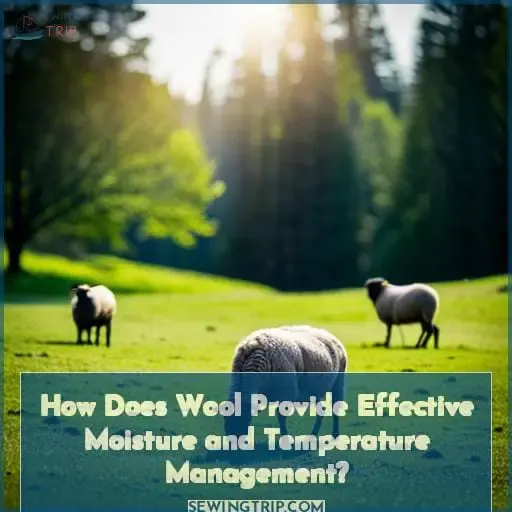This site is supported by our readers. We may earn a commission, at no cost to you, if you purchase through links.
 When it comes to comfort and breathability, wool reigns supreme – like a monarch surveying their kingdom. Wool offers superior temperature regulation, moisture management, insulation properties, and odor-resistance compared to other fabrics such as cotton or synthetic fibers.
When it comes to comfort and breathability, wool reigns supreme – like a monarch surveying their kingdom. Wool offers superior temperature regulation, moisture management, insulation properties, and odor-resistance compared to other fabrics such as cotton or synthetic fibers.
But is wool truly breathable? This article dives into the details of why this natural fabric stands out from the rest when it comes to air flow and performance in various settings. We’ll explore how wool’s unique 3D crimp creates pockets of air that provide excellent insulation while allowing for better airflow than most synthetics can manage.
Additionally, we’ll discuss how merino wools’ finer fibers make them more comfortable. We’ll also address whether mineral wools are considered breathable. Furthermore, we’ll examine if there’s any truth behind wool’s reputation for keeping you cool on hot days.
Lastly, we’ll explore its reported ability to reduce post-exercise chill after physical activity has ceased.
So get ready to learn all about what makes this centuries-old textile so popular today!
Table Of Contents
- Key Takeaways
- Is Wool Breathable?
- How Does Wool Provide Effective Moisture and Temperature Management?
- What is the Natural Crimp of Wool and How Does It Provide Superior Insulation?
- Does Wool Reduce Post-Exercise Chill?
- Can Wool Keep You Cooler in Hot, Dry Environments?
- Does Wool Have Odor-Resistant Properties?
- Why is Merino Wool Considered Breathable?
- Is Mineral Wool Breathable?
- Is Wool More Breathable Than Cotton?
- Can Wool Be Worn Comfortably in the Summer?
- Conclusion
Key Takeaways
- Wool’s superior breathability makes it an ideal fabric for various purposes.
- The 3D crimp of wool creates air pockets that provide insulation and airflow.
- Merino wool, with its finer fibers, enhances comfort and breathability.
- Wool conducts heat away from the body in hot conditions, keeping the skin dry.
Is Wool Breathable?
When it comes to regulating your body temperature and effectively managing moisture, you’ll find that wool keeps you comfortable and feeling fresh. Wool, especially the fine fibers of merino wool, is highly breathable and creates air pockets for optimal temperature regulation.
It outperforms synthetic fabrics like polyester in terms of breathability due to its natural crimp.
The superior insulation properties of wool help maintain a drier microclimate next to the skin by reducing skin cooling and post-exercise chill. Additionally, wool has the ability to absorb up to 35% of its weight before feeling wet while releasing heat at the same time.
Compared to cotton, which is also known for being breathable but lacks some key features found in merino wool such as moisture-wicking capabilities or advanced thermal regulation abilities during exercise activities where intensive sweating occurs; therefore making it less suitable as sportswear material when considering these factors specifically related towards athletic performance requirements – this makes choosing between these two types dependent on usage preferences based on weather conditions encountered throughout various seasons.
So if you’re looking for a fabric that can keep you dry and comfortable even during intense physical activities or hot summer days, is breathable, then look no further than woollen garments made from Merino Wool!
How Does Wool Provide Effective Moisture and Temperature Management?
You’d stay comfortable wearing wool because it absorbs moisture before feeling damp against your skin, then releases the heat gained to keep you warm and dry. Wool’s unique structure allows it to effectively manage both moisture and temperature, making it an ideal choice for various activities and weather conditions.
Here’s how wool provides effective moisture and temperature management:
- Wool’s natural crimp creates air pockets within the fabric, allowing for better insulation while still maintaining breathability.
- When you sweat or come into contact with water, wool fibers have a high capacity to absorb this moisture without feeling wet on your skin.
- As the absorbed moisture evaporates from the surface of the wool fibers, heat is released in a process known as heat of sorption, which helps regulate body temperature.
This combination of absorbing excess sweat while releasing heat makes wool an excellent option during exercise or intense physical activity. It reduces post-exercise chill by keeping your skin drier compared to other fabrics like polyester.
Even in hot environments, where one might assume that wearing any type of insulating fabric would be uncomfortable – think again! Wool conducts heat away from your body in these conditions due to its breathable nature.
Additionally, wool moves 25% more moisture away from your skin than polyester does—allowing you to feel cooler even when temperatures rise.
So whether you’re braving chilly winds or facing scorching sun rays, wool has got you covered with its exceptional properties for comfort through efficient moisture management and superior temperature regulation capabilities.
What is the Natural Crimp of Wool and How Does It Provide Superior Insulation?
Wool’s unique wavy structure called crimp creates tiny air pockets within the fabric. This traps warm air close to your body, acting as an excellent insulator to prevent heat loss and keep you warm even in cold conditions.
In addition, wool effectively manages moisture by absorbing sweat from your skin and releasing it through evaporation.
Thanks to its breathability and ability to react to body temperature changes, wool helps regulate your body heat. It allows excess heat and moisture vapor to escape while retaining warmth when needed.
With wool’s natural crimp and other inherent qualities like:
- Breathability
- Temperature regulation
- Moisture management
Wool provides unparalleled comfort for various activities – from outdoor adventures to everyday wear. Whether you’re tackling intense workouts or simply enjoying nature’s wonders, wearing breathable wool will keep you feeling comfortable and confident throughout your day.
With all these benefits combined, natural wool truly emerges as one of the most versatile and reliable textiles available today.
Does Wool Reduce Post-Exercise Chill?
Yet peak wool’s effectiveness, it’s ideal for base layers that lessen post-workout chills. Your search for post-exercise comfort ends with merino wool. Its unparalleled moisture management keeps you dry.
Merino’s breathability regulates temperature, preventing that clammy chill. The crimped fibers trap air, providing insulation. Yet the moisture-wicking releases perspiration to the surface, where it evaporates rapidly, leaving you dry and comfy.
Temperature regulation at its finest. Merino wool excels from the gym to the trail. Wicking sweat while managing your microclimate. As natural athletic fibers go, wool outperforms. So choose your next baselayer wisely. Pick merino wool for ultimate temperature control.
Staying dry and warm, workout after workout. No need to endure post-exercise chills.
Can Wool Keep You Cooler in Hot, Dry Environments?
In warm, arid climates, wool can move moisture away faster and feel cooler against your skin than synthetics. Its fiber structure creates pockets of air that provide natural ventilation. When you wear wool in the heat, it absorbs perspiration before it accumulates.
The evaporation of moisture creates a cooling effect. Air circulation keeps you dry and comfortable.
The crimp and breathability of wool make it ideal for hot weather wear. Finer wool with a looser weave feels cooler as it allows more airflow. Alpaca wool is extremely breathable. While cotton may seem cooler, it doesn’t wick moisture as fast.
For staying drier and more comfortable when active in the heat, wool outperforms other fabrics.
Does Wool Have Odor-Resistant Properties?
Wool has natural odor-resistant properties y’all’d love. The fibers in wool fabric have scales that create friction, trapping odors before they can waft off the garment. This helps wool clothing resist body odors from sweat compared to other fabrics like cotton.
Wool’s odor resistance comes from its natural protective outer layer called lanolin. Lanolin creates a waxy coating that prevents stains and odors from setting into the wool fibers.
The tight structure of wool fabric also makes it harder for odors to pass through the material. Of course, wool can eventually absorb odors over time and with wear. But its intrinsic odor-blocking abilities let wool keep its fresh scent far longer than other textiles.
While wool may have a higher price tag, its unbeatable odor control gives it staying power that makes it worth the investment.
Why is Merino Wool Considered Breathable?
Merino wool is considered breathable due to its fine fibers, which allow more air flow by creating small pockets that circulate and regulate temperature next to your skin. The natural crimp of merino wool gives it superior moisture control, further contributing to breathability during exercise.
Alpaca wool shares similar properties with merino that promote breathability. The fine fibers of alpaca and merino wool allow for air circulation by forming tiny pockets near the skin that help control temperature.
Breathability is also enhanced by wool’s natural ability to wick moisture. Both merino and alpaca use their crimped fibers to efficiently absorb and evaporate perspiration. This moisture control lends itself to greater breathability, especially during physical activity.
Merino wool’s air pockets
Imagine yourself wrapped in a cozy, cloud-like fabric that creates tiny pockets of air to regulate your body temperature. Merino wool’s crimped fibers form thousands of tiny air pockets that trap body heat.
- Allow your skin to breathe, wicking moisture away
- Keep you warm yet cool by holding a layer of insulating air
- Adapt to your body temperature like a microclimate system
- Make the fabric feel lightweight instead of sweltering
The springy, three-dimensional structure of the wool fibers gives merino unrivaled breathability and temperature control.
Fine fibers increase breathability
You feel the soft caress of merino wool against your skin, the fine fibers creating a lightweight breeze across your body. These fine fibers are what make merino wool so incredibly breathable. They create tiny air pockets that allow for excellent moisture control and temperature regulation.
The breathability benefits of merino wool come from its unique combination of natural characteristics, making it an ideal choice for those seeking comfort and performance in their clothing. With merino wool, you can stay cool when it’s hot and warm when it’s cold without compromising on breathability or comfort.
Alpaca wool’s breathability
To understand the breathability of alpaca wool, imagine yourself wearing a cozy sweater that allows air to circulate effortlessly, keeping you comfortably cool in warmer climates. Alpaca wool possesses unique properties that contribute to its breathability. The natural structure of alpaca fibers creates tiny pockets within the fabric, allowing for better airflow and moisture management.
Compared to cotton, alpaca wool has superior moisture-wicking capabilities and can move moisture away from your skin more efficiently. This makes it an excellent choice for those seeking breathable fabrics with optimal comfort and performance.
Is Mineral Wool Breathable?
Mineral wool, though it has its uses in insulation, may not be the best choice for clothing due to its potential for skin irritation and inclusion of industrial waste.
- Rough texture can cause itchiness and rashes when in prolonged contact with skin.
- Fibers may break off and get lodged in skin, causing irritation that’s difficult to remove.
- It contains recycled industrial waste like slag and glass that don’t belong next to human skin.
While mineral wool is breathable, allowing air to pass through tiny air pockets between its fibers, the material itself is too coarse and hazardous for direct skin contact in clothing. The rigid, dense structure of mineral wool makes it effective for insulation but unsuitable for wearable fabrics.
Though it allows airflow, mineral wool lacks the softness, moisture-management, and comfort demanded for apparel. For clothing purposes where breathability and skin health are priorities, natural fibers like cotton and wool, or high-tech synthetic performance fabrics would be better options than mineral wool.
Is Wool More Breathable Than Cotton?
When it comes to comparing fabrics, cotton and wool differ in their ability to provide comfort in varying weather conditions. If you’re looking for a breathable fabric that can keep you cool during the summer months, merino wool might just be your best bet.
Merino wool is known for its exceptional moisture management properties and superior breathability compared to cotton. The fine fibers of merino wool create tiny air pockets that allow heat and moisture to escape, keeping you dry and comfortable even on hot days.
There’s no contest in terms of breathability comparison between merino wool and cotton – merino wins hands down. While cotton is also breathable, it tends to hold onto moisture rather than wicking it away like merino does.
This means that when you sweat in a cotton garment, the fabric becomes damp and clings uncomfortably to your skin.
Merinos are masters at regulating temperature because they react dynamically with our body’s changing needs by transferring heat or absorbing water vapor efficiently through their complex structure of crimped fibers which allows them to move 25% more moisture away from the skin than polyester.
This makes them perfect companions for outdoor activities or intense workouts where staying dry is crucial.
If staying cool and comfortable during warm weather is your priority then choose lightweight clothing made from high-quality Merinos over conventional materials such as Cottons which tend to trap moisture.
Can Wool Be Worn Comfortably in the Summer?
You’d be surprised how comfortable and cool you’ll feel wearing wool in the scorching summer heat. As an expert in textile properties, I can assure you that wool’s natural moisture-wicking abilities make it an ideal summer fabric.
The crimped wool fibers form millions of tiny air pockets that allow your sweat to evaporate quickly. Recent advancements in wool manufacturing like superwash treatments also prevent wool from shrinking or felting when wet.
The soft, lightweight merino wool layers will keep you dry and thermoregulated in the hottest weather. While cotton gets soggy with sweat, wool actively pulls moisture away from your skin.
The breathability comes from wool’s hygroscopic properties and moisture-wicking crimp structure. Ultimately, wool’s natural climate control and odor resistance give you cooling comfort and freedom, making it the perfect liberating yet cozy fabric for hot summer adventures.
Conclusion
It’s no surprise that wool is highly breathable. With its natural crimp, superior insulation, and ability to reduce post-exercise chill, this fabric is a great choice for those looking to stay comfortable in any climate.
Merino wool, in particular, stands out among its counterparts with its fine fibers that create air pockets for temperature regulation. Even mineral wool, used mainly for insulation, provides a level of breathability and can be worn in hot, dry environments—provided it doesn’t irritate the skin.
When compared to cotton, wool is the clear winner in terms of breathability and moisture-wicking capabilities. So, if you’re looking for a breathable fabric that offers superior insulation and temperature regulation, wool is an excellent option.













